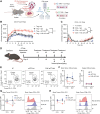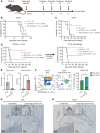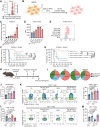Fc-enhanced anti-CTLA-4, anti-PD-1, doxorubicin, and ultrasound-mediated blood-brain barrier opening: A novel combinatorial immunotherapy regimen for gliomas
- PMID: 39028616
- PMCID: PMC11534315
- DOI: 10.1093/neuonc/noae135
Fc-enhanced anti-CTLA-4, anti-PD-1, doxorubicin, and ultrasound-mediated blood-brain barrier opening: A novel combinatorial immunotherapy regimen for gliomas
Abstract
Background: Glioblastoma is a highly aggressive brain cancer that is resistant to conventional immunotherapy strategies. Botensilimab, an Fc-enhanced anti-CTLA-4 antibody (FcE-aCTLA-4), has shown durable activity in "cold" and immunotherapy-refractory cancers.
Methods: We evaluated the efficacy and immune microenvironment phenotype of a mouse analogue of FcE-aCTLA-4 in treatment-refractory preclinical models of glioblastoma, both as a monotherapy and in combination with doxorubicin delivered via low-intensity pulsed ultrasound and microbubbles (LIPU/MB). Additionally, we studied 4 glioblastoma patients treated with doxorubicin, anti-PD-1 with concomitant LIPU/MB to investigate the novel effect of doxorubicin modulating FcγR expressions in tumor-associated macrophages/microglia (TAMs).
Results: FcE-aCTLA-4 demonstrated high-affinity binding to FcγRIV, the mouse ortholog of human FcγRIIIA, which was highly expressed in TAMs in human glioblastoma, most robustly at diagnosis. Notably, FcE-aCTLA-4-mediated selective depletion of intratumoral regulatory T cells (Tregs) via TAM-mediated phagocytosis, while sparing peripheral Tregs. Doxorubicin, a chemotherapeutic drug with immunomodulatory functions, was found to upregulate FcγRIIIA on TAMs in glioblastoma patients who received doxorubicin and anti-PD-1 with concomitant LIPU/MB. In murine models of immunotherapy-resistant gliomas, a combinatorial regimen of FcE-aCTLA-4, anti-PD-1, and doxorubicin with LIPU/MB, achieved a 90% cure rate, that was associated robust infiltration of activated CD8+ T cells and establishment of immunological memory as evidenced by rejection upon tumor rechallenge.
Conclusions: Our findings demonstrate that FcE-aCTLA-4 promotes robust immunomodulatory and anti-tumor effects in murine gliomas and is significantly enhanced when combined with anti-PD-1, doxorubicin, and LIPU/MB. We are currently investigating this combinatory strategy in a clinical trial (clinicaltrials.gov NCT05864534).
Keywords: BBB; Fc-enhanced anti-CTLA-4; doxorubicin; glioblastoma; immunotherapy.
© The Author(s) 2024. Published by Oxford University Press on behalf of the Society for Neuro-Oncology. All rights reserved. For commercial re-use, please contact reprints@oup.com for reprints and translation rights for reprints. All other permissions can be obtained through our RightsLink service via the Permissions link on the article page on our site—for further information please contact journals.permissions@oup.com.
Conflict of interest statement
A.M.S. and R.St. have received in-kind and/or funding support for research from Agenus, BMS, and CarThera. A.M.S., V.A.A., K.S.K., C.A., and R.St. are co-authors of IP filed by Northwestern University related to the content of this manuscript. A.M.S. is a paid consultant for Carthera and Enclear Therapies. R.St. has acted or is acting as a scientific advisor or has served on advisory boards for the following companies: Alpheus Medical, AstraZeneca, Boston Scientific, CarThera, Celularity, GT Medical, Insightec, Lockwood (BlackDiamond), Northwest Biotherapeutics, Novocure, Inc., Syneos Health (Boston Biomedical), TriAct Therapeutics, Varian Medical Systems. M.C. is an employee and holds ownership interest in Carthera, as well as patents related to the ultrasound technology described herein. R.R. is a founder and a member of the Avisory Board of Genotwin, Diatech Pharmacogenetics, and a consultant for Arquimea Research. None of these activities are related to the work described in this manuscript. D.C., B.M.M., and D.L. are employees of Agenus Bio. All other authors declare that they have no competing interests.
Figures






References
-
- Miller KD, Ostrom QT, Kruchko C, et al. Brain and other central nervous system tumor statistics, 2021. CA Cancer J Clin. 2021;71(5):381–406. - PubMed
-
- Janjua TI, Rewatkar P, Ahmed-Cox A, et al. Frontiers in the treatment of glioblastoma: past, present and emerging. Adv Drug Deliv Rev. 2021;171(1):108–138. - PubMed
MeSH terms
Substances
Associated data
Grants and funding
LinkOut - more resources
Full Text Sources
Medical
Research Materials
Miscellaneous

